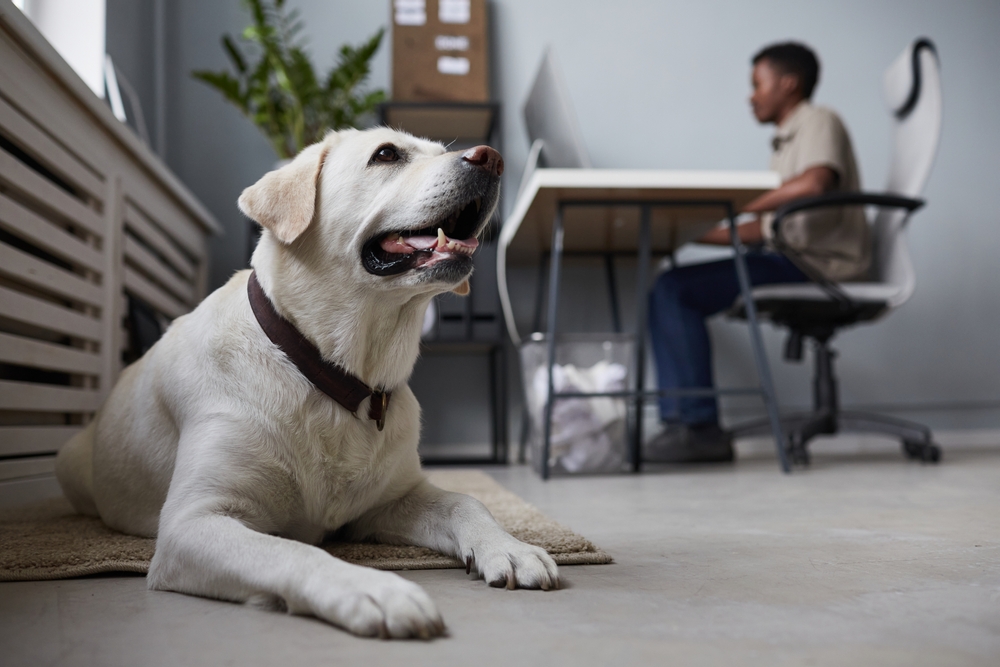Facilities professionals whose human resources (HR) departments have pet-friendly policies should retrofit their buildings to make them more accommodating for felines, canines, and their owners.

Owners Miss Their Pets
The trend toward more pet-friendly workplaces comes after more than 23 million American households acquired a cat or dog between March 2020 and May 2021, during the height of the pandemic, according to the American Society for the Prevention of Cruelty to Animals (ASPCA).
Over the past 4 years, people who were working from home because of COVID have been returning to the office, even if just on a hybrid basis, and they miss spending time with their favorite felines and canines.
Establish Clear Policies
Better Cities for Pets encourages facilities managers to work directly with HR to ensure the organization’s pet policy spells out responsibilities, pet requirements, and pet parent responsibilities.
Facilities managers should also have cleaning supplies available for pet accidents with signage on how to use them and directions on how to call facilities personnel so areas can be properly sanitized.
Successful pet-friendly policies have been established in many types of facilities, according to Purina, including hospitals, schools, dentist’s offices, and car detailing shops.
Here are four ways facilities professionals can make their facilities pet-friendly:
1. Designate Areas for Food and Water
Create hydration areas for fresh water and food that are out of employees’ path of travel. Consider purchasing automated water and food bowls for the facility, but if this isn’t possible, ensure water is refilled throughout the day, and ask pet owners to bring food and bowls for their pets.
No matter who cleans and maintains the bowls, they should follow the manufacturer’s instructions.
Additionally, pet owners should be encouraged to keep additional treats in their drawers or cabinets—out of reach of pets—to reward good behavior but also to be careful not to overfeed their animals.
2. Build Outdoor Recreational Spaces
Build a dog park! It should have 4- to 6-foot fencing with exercise equipment and a separate area for small dogs. If a dog park isn’t possible, designate a large grassy area for dogs. Either way, install poop bag stands to make cleanup easier for dog owners.
For feline fans, purchase or build an outdoor enclosure called a “catio” for outdoor cats to enjoy where they would be protected from predators.
In these outdoor pet facilities, install benches and waste receptacles for humans, as well as water stations for both humans and animals. However, the ASPCA notes that outdoor landscaping shouldn’t include toxic plants.
3. Recreate Interior Spaces
Provide designated spaces for dog toys, beds, blankets, mats, carriers, and crates. For more dog-friendly fun, set up indoor dog play areas in your facility, and follow the lead of employer Mars Petcare! Also, customize desks so dog owners can more easily tether their dogs to them.
For cats, consider creating a cattery, a room where cats can play together with climbing trees, scratching posts, toys, and litter boxes. If this isn’t possible, at least provide an area for cat furniture away from desks so felines won’t disturb their owners with smells and sounds while they’re working.
Designate at least one nearby pet relief area with a pet waste station and trash, which needs to be regularly emptied by facilities management.
Also, just like with the outdoors, make sure indoor plants aren’t toxic.
4. Limit Where Pets Can Go
Certain places in your facility should be designated pet-free in order to obey the law, protect sensitive areas, and ensure those who are allergic or have a fear of animals won’t be uncomfortable in the workplace.
Prohibited areas should include kitchens, cafeterias, break rooms, meeting rooms, laboratories, offices of those who are allergic, and places with equipment or materials that could be broken or harmful to pets. Organizations must also comply with town, state, and federal requirements that prohibit pets in specific facility areas for health reasons.
However, the Americans with Disabilities Act (ADA) requires employers to accommodate service animals that assist employees with a disability.
Learn More
Facilities professionals should make improvements to their facilities to make them pet-friendly. To learn more helpful steps, click here.
For issues that facilities management and HR should consider before making their worksites pet-friendly, read “What to Consider Before Becoming a Pet-Friendly Workplace” on HR Daily Advisor.
